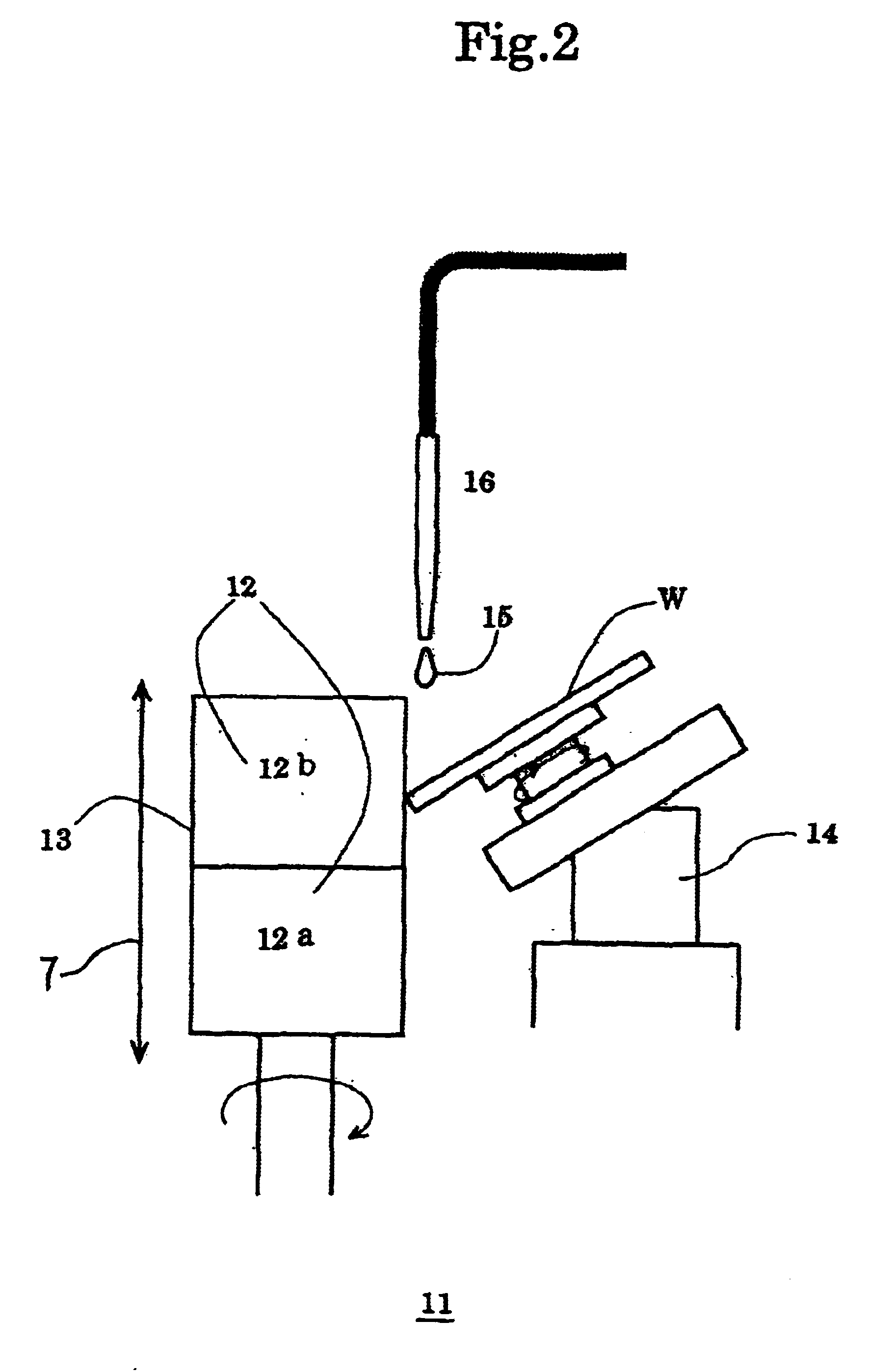Method for apparatus for polishing outer peripheral chamfered part of wafer
a technology of peripheral parts and apparatus, which is applied in the direction of grinding drives, manufacturing tools, lapping machines, etc., can solve the problems of defective subsequent process, poor production yield of subsequent process, and insufficient cleaning of chemicals used in etching process, so as to improve the productivity of the polishing process and reduce the polishing time
- Summary
- Abstract
- Description
- Claims
- Application Information
AI Technical Summary
Benefits of technology
Problems solved by technology
Method used
Image
Examples
example 1
[0037]Using two sets of polishing apparatuses shown in FIG. 4, polishing for the chamfered peripheral part of a wafer was performed with a first polishing apparatus on the similar condition to that of Comparative Example 1 by rotating the wafer at 40 seconds per round as a rough polishing (a first polishing) and then with a second polishing apparatus on the similar condition to that of Comparative Example 2 as a fine polishing (a second polishing). The two separate sets of polishing apparatuses herein were constructed so as to be changed in sequence at the time of the first polishing and then the second polishing and so that the chamfered part of the wafer was contacted to each drum at the same set value of polishing pressure.
[0038]In the above described examples and comparative examples, the polishing was operated by rotating the wafer only one round at an operation and the surface roughness of the polishing part was measured. The shorter the time for one round, i.e. the more rapid...
example 2
[0041]A second illustrative embodiment of the present invention will now be described with reference to FIG. 2.
[0042]A polishing apparatus 11 comprises a rotating drum 13 affixed with a polishing cloth 12 to the surface thereof, a wafer rotating part 14 which press the chamfered peripheral part of the wafer W against the rotating drum 13 while rotates the wafer thereon, a linear moving means which moves the rotating drum and the wafer rotating part relatively in up and down directions along the axis of the rotating drum 13 as illustrated by the arrow 7, and a nozzle 16 which supplies polishing slurry 15 to the contact spot of the polishing cloth to the chamfered peripheral part of the water W. The polishing apparatus 1 is also capable of controlling variably the wafer rotating rate and the processing pressure. Further, the polishing cloth 12a, 12b affixed to the rotating drum varied by two steps along the direction of the rotating axis of the rotating drum so as to vary the hardness...
example 3
[0046]The region around {110} plane of the chamfered peripheral part of a wafer was polished as a first polishing and then the whole chamfered peripheral part was polished on the other condition as a second polishing. The first polishing was performed using two apparatus shown in FIG. 4 having a cloth of unwoven type polishing cloth of Asker c hardness of 62 with slurry containing fumed silica. The region around {110} plane of the chamfered peripheral part of a wafer was polished at a low rate of wafer rotation and with a high pressing pressure to the cloth. The more specifically, the region around {110} plane, i.e. the ±15° angle region from the center spot of direction, of the chamfered peripheral part of a wafer was polished at a 2 / 3 rate of wafer rotation compared to the other part with a pressing pressure of 1.5 times as strong as the other part so as to improve the roughness of the {110} plane region particularly.
[0047]Thus the roughness of the {110} plane was improved up to ...
PUM
| Property | Measurement | Unit |
|---|---|---|
| diameter | aaaaa | aaaaa |
| optical roughness gauge | aaaaa | aaaaa |
| optical roughness gauge | aaaaa | aaaaa |
Abstract
Description
Claims
Application Information
 Login to View More
Login to View More - R&D
- Intellectual Property
- Life Sciences
- Materials
- Tech Scout
- Unparalleled Data Quality
- Higher Quality Content
- 60% Fewer Hallucinations
Browse by: Latest US Patents, China's latest patents, Technical Efficacy Thesaurus, Application Domain, Technology Topic, Popular Technical Reports.
© 2025 PatSnap. All rights reserved.Legal|Privacy policy|Modern Slavery Act Transparency Statement|Sitemap|About US| Contact US: help@patsnap.com



